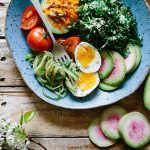All women (and arguably some men) go through their monthly PMS, but it’s ugly twin dysmenorrhea often goes undiscussed.
Dysmenorrhea specifically refers to pain you may experience during your menstrual cycle (as opposed to PMS pains that happen beforehand). Symptons — in case you need reminding — are primarily pain, accompanied by the irritability, fatigue, mood swings, bloating and even food cravings of PMS. The pain specifically is thought to be caused by the natural contractions of the uterus. This monthly process is not only natural and necessary but also a wonderful way in which your body can cleanse and renew itself.
That being said, sometimes stress, disease or a bad diet can trigger heightened pain episodes because of your period and make you feel uncomfortable. Pain triggered by these factors is completely avoidable and unnecessary, and you really shouldn’t have to go through it. Here are a couple snacks you should try during your period to ease the process:
1. Think and Eat Orange
Foods that include Vitamin A, like carrots, sweet potatoes and apricots, are a great addition to your diet (and also happen to be in season in the fall). Our Vitamin A levels have been shown to help our bodies with iron regulation and the creation of new red blood cells. Also, retinoic acid (RA), which is naturally obtained from Vitamin A, helps in the maintenance and regulation of your reproductive system and menstrual cycle.
2. Grab A Few Almonds
Almonds are a good source of healthy fats and they’re very rich in Vitamin E, a powerful antioxidant, which helps prevent swelling or aching breasts that commonly accompany your period. Almonds are also rich in magnesium which may be helpful for relieving the symptoms of dysmenorrhea. Other foods that provide a good amount of Vitamin E are sunflower seeds, cooked spinach, olives and dried apricots.
3. Drink Camomile
Camomile contains glycine which is a chemical that helps relieve muscle spasms and is often prescribed for it’s calming effect on the nerves. Specifically during your period, higher glycine levels help relax the uterus, which is why drinking camomile is often recommended to ease pain.
4. Beans And Pulses
A common issue that accompanies blood loss is lower iron levels. Luckily, beans and pulses are full of the stuff and help your body regain the amount of iron lost on your period. Pulses are also rich in protein and complex carbohydrates and are a better way to balance your glucose levels than sugary supplements that may end up adding to the pain.
5. Probiotics
Although these healthy bacteria are tiny, they are mighty for what they can do to help reduce PMS symptoms. They achieve this by increasing the activity of an enzyme in your body called beta-glucuronidase which promotes the production of estrogen. Estrogen is the hormone in charge of the growth of the uterine lining during the first part of your menstrual cycle and also assists with bone growth and cholesterol levels. Probiotics can be found in yogurt, fermented beverages and milks and you may even find them in dairy-free gels or capsules.
So to sum it all up:
| Condition | Cause | Symptoms | What to eat/drink | What to avoid | |
| PMS | Hormone Changes | Irritability, fatigue, mood swings, bloating and cravings. | Complex carbohydrates like fruits, vegetable and whole grains. | Sugar sweetened food and drinks. | |
| Dysmenorrhea | Natural Menstruation Act | Pain and cramps in the abdomen area. Lower back pain. | Camomile, carrots, sweet potatoes, apricots, almonds, leafy greens, nuts, seeds, fish, beans, avocados, yogurt, bananas, dried fruit. | Stress, sugary food and drinks, caffeine, foods high in unhealthy fats. |
A 2-Step Snack To Banish Period Pain
This nutritious recipe has excellent sources of beta-carotene which will help keep your womb in good shape during menstruation.
What you need
- 1 small sweet potato, keep the skin for fibre.
- 1 fistful of almonds
- A sprinkle of cinnamon and ginger
- 2-3 slides of pineapple
What to do
- Cook and crush the sweet potatoes.
- Add and mix the pineapple slices, almonds and cinnamon and ginger and enjoy!
This recipe is especially great since the cinnamon helps with the gradual absorption of the complex carbohydrates from the almonds and the natural sugars found in the pineapple, while the ginger contains anti-inflammatory properties.
Don’t Suffer During Your Period!
Learning what foods to eat and which ones to avoid dysmenorrhea and PMS-like symptoms can be easier than you think. Try substituting fries and chips for boiled or baked sweet potatoes, sprinkle cinnamon and ginger over your dishes, increase the amount of pulses you eat in the week and swap them for meat every once in a while. If you’re in pain, try camomile instead of coffee and include probiotics in your regular diet. Have you got any other tips and recipes? Share them with us by posting them below!













